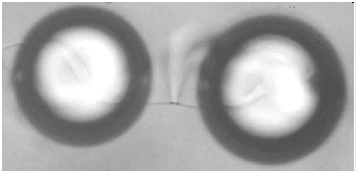Status:
Completed
Period
16 September – 16 December 2019
Applicant
Martina Clairand Gomez (PhD candidate)
Home Institution
Gulliver Lab, École supérieure de physique et de chimie industrielles de la ville de Paris (ESPCI).
Host Contact
Dr. Jordi Ignés Mullol
Host Institution
Self-organized complexity and self-assembling materials (SOC&SAM), University of Barcelona.
Aim of the mission
The aim of this collaborative project is to study the defect-mediated assembly of active nematic droplets embedded in a passive liquid crystal, in terms of both structure and collective dynamics. From a fundamental point of view, this study will elucidate the synchronization of biological oscillators, observed for example in the cooperative action of micrometre-sized cytoskeletal elements involved in the transport of material within cells. Beyond this interest, in the future, we can envisage the realization of functional soft materials capable of locomotion by its synchronous dynamics.
Summary of Results:
By emulsifying the aqueous kinesin/tubulin active gel within the 5CB liquid crystal in an automated way, we produced a row of equally spaced droplets which were linked to their neighbors with a disclination line. Initially, the droplets assemble into linear chains but with time the binding disclination retracts and
the droplets approach each other. Usually, the linear structure breaks up and reorganizes either into shorter chains or into non-linear clusters, which appear to be more stable.
Effect of the anchoring at the cell boundaries
Varying the anchoring at the cell boundaries, from planar to homeotropic, determined the spatial arrangement of defects (SR and boojums), revealing the hexadecapolar configuration of the passive nematic around the aqueous droplets.
Types of interactions and loops
We recorded three different types of defect interactions: SR-SR, Boojum-Boojum and SR-Boojum interactions. The last two cases occur when the separation distance between droplets is small compared to the droplet diameters. Although the specific mechanisms giving rise to these interactions are still not well understood they conduct to robust, long lasting assemblies. For SR-SR interactions, some unstable configurations result when a single giant loop encircles the chain without knotting neighboring droplets between them. Conversely, more robust and persistent dynamics are obtained when the droplets are connected through entangled hyperbolic defects. In particular, we
reach synchronous dynamics for linear chains up to eight droplets under certain specific conditions.
Dissemination
In the near future, we envisage to collaborate with J. De Pablo team from the University of Chicago as they have a strong background in simulating both active and passive liquid crystals in spherical geometries. Combining the experimental results with numerical simulations is essential to understand the patterns observed in these systems where many different forces are at play. We plan also to publish these results in international scientific journals dealing with topology and active matter.

